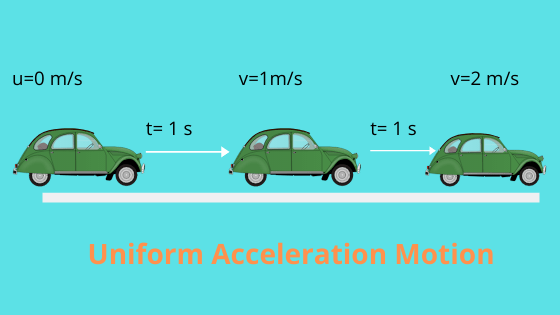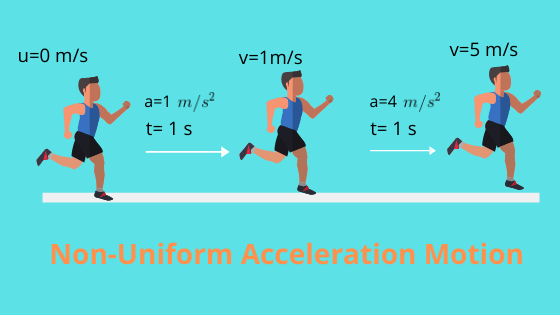Motion in one dimension is the motion where the object moves in a straight line. So, it is also sometimes called Motion in a straight line. There is another name that you often hear in 1D Motion. These all synonyms and mean the same thing.
Now Motion in one dimension formulas can be divided based on whether the motion is uniform or Uniform. Uniform means acceleration is constant and Non -Uniform means acceleration is not constant and varying
Lets First see the Formulas For one dimension Uniform Motion i.e When acceleration is constant

$v=u+at$
$s=ut+ \frac {1}{2}at^2$
$v^2=u^2+2as$
$\text{Average velocity} = \frac {u+v}{2}$
Here
v -> Final Velocity (m/s)
u->Initial Velocity(m/s)
a -> Acceleration($ m/s^2 )$
t -> Time (sec)
s-> displacement
These together is called the equation of Motion also
If we are considering the initial Displacement also, then these formula can be written as
$v=u+at$
$x – x_0=ut+ \frac {1}{2}at^2$
$v^2=u^2+2a(x- x_0)$
$\text{Average velocity} = \frac {u+v}{2}$
Where $x_0$ is the initial displacement and $x$ is the final displacement
Example
A plane starts from rest and accelerates along the ground before the takeoff.It moves 500 m in 10 sec. Find
(a) Acceleration
(b)Velocity at the end of 10 sec
(c) Distance moves during the 10th sec
Answer
Given u =0, s= 500 m, t=10 sec
(a) From second equation
$s = ut + \frac {1}{2}at^2$
$500 = 0 + \frac {1}{2} a \times 100$
$a= 10 m/s^2$
(b) From First Equation
$v= u+ at$
$v= 0 + 10 \times 10 =100 m/s$
(c) Distance moves during the 10th sec = Distance moved in 10 sec – Distance moved in 9 sec
Distance moved in 10 sec=600 m(given)
Now Distance Moved in 9 sec will be calculated using second equation of Motion
$ s = ut + \frac {1}{2}at^2$
$= 0 + \frac {1}{2} \times 10 \times 81 = 405 m$
Hence Distance Moved in 10th sec= 600 – 405 = 195 m
Now Lets see what are the Formulas in the case of Non-Uniform One Dimension Motion

$$v= \frac {dx}{dt}$$ $$a=\frac {dv}{dt}= \frac {d^2x}{dt^2}$$ $$a=v \frac {dv}{dx}$$ $$x=\int v dt $$ $$v=\int a dt $$ $$\text {Average Velocity} = \frac {\text {total Displacement}}{\text {time taken}}$$ $$\text {Average Speed} = \frac {\text {total Distance}}{\text {time taken}}$$ $$\text {Average Acceleration} = \frac {v_2 – v_1}{t}$$
Example
A object moving along the x-axis has a velocity given by $v=4t – 2.5t^2$ m/s for t in sec. find its acceleration at (a) t=1 sec , (b) t= 3 sec
Answer
$v=4t – 2.5t^2$
Acceleration is given by
$a= \frac {dv}{dt} = 4 – 5t$
Acceleration at t=1 sec
$a= 4 – 5 = -1 m/s^2$
Acceleration at t=3 sec
$a= 4 – 15 = -11 m/s^2$
Further reference and reading
In Physics it is important to know what is motion? Motion and its study lay the basic foundation for the student who wants to study physics. It is important for students to master these concepts.
If you want to dive further and learn more about motion and kinematics you can consider buying the book
Interactive Physics Part 3.
This book covers most portions of Mechanics. It gives you a thorough grounding in Physics and imparts skills so that you can tackle IIT JEE, Engineering and Medical entrance exams with confidence. The application methods and concepts/misconceptions can be applied to various entrance examinations (IIT JEE, JEE Main, NEET, AIIMS, JIPMER, BITSAT etc.)
For those of you who are interested in video tutorials can look at this video course by udemy
Mastering Kinematics
This course will guide you to solve any, one and two-dimensional kinematics problem, using kinematics equations and solving graphical problems. Through this course, you can learn how to solve relative motion problems such as river crossing problems
These are the set of two books for class 11 physics. These books are written in easy language.
Note to our visitors:-
Thanks for visiting our website.
DISCLOSURE: THIS PAGE MAY CONTAIN AFFILIATE LINKS, MEANING I GET A COMMISSION IF YOU DECIDE TO MAKE A PURCHASE THROUGH MY LINKS, AT NO COST TO YOU. PLEASE READ MY DISCLOSURE FOR MORE INFO.
